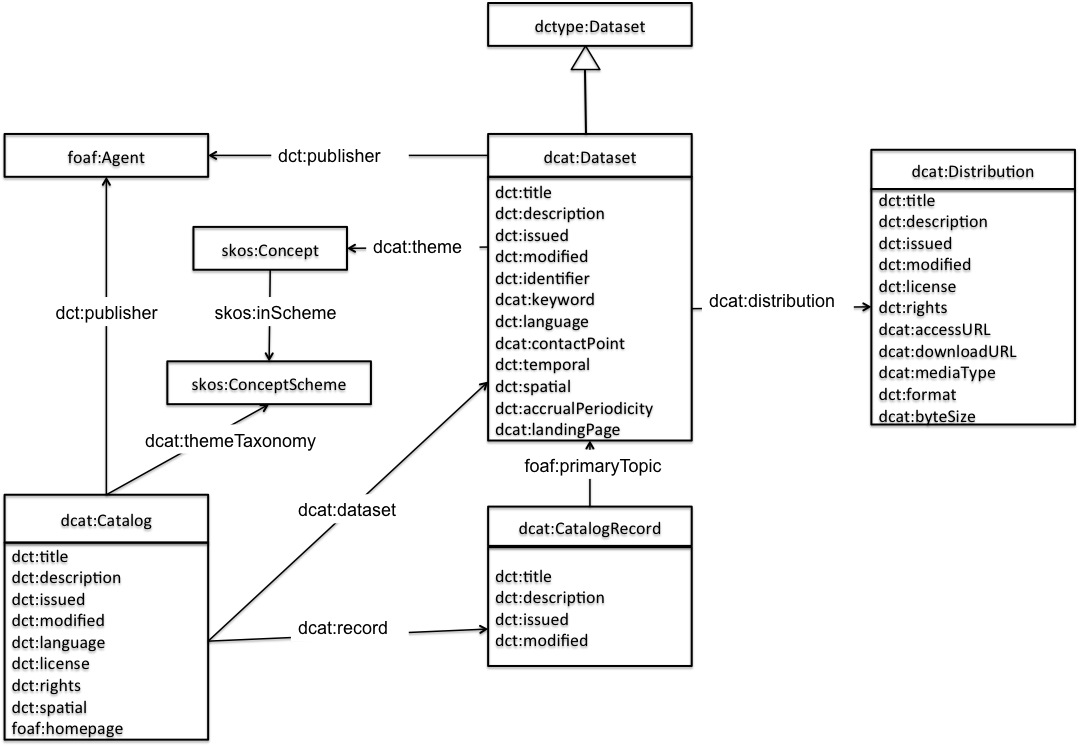Vocabulary Overview
DCAT is an RDF vocabulary well-suited to representing government data catalogs such as Data.gov and data.gov.uk. DCAT defines three main classes:
-
dcat:Catalogrepresents the catalog -
dcat:Datasetrepresents a dataset in a catalog. -
dcat:Distributionrepresents an accessible form of a dataset as for example a downloadable file, an RSS feed or a web service that provides the data.
Notice that a dataset in DCAT is defined as a "collection of data, published or curated by a single agent, and available for access or download in one or more formats". A dataset does not have to be available as a downloadable file. For example, a dataset that is available via an API can be defined as an instance of dcat:Dataset and the API can be defined as an instance of dcat:Distribution. DCAT itself does not define properties specific to APIs description. These are considered out of the scope of this version of the vocabulary. Nevertheless, this can be defined as a profile of the DCAT vocabulary.
Another important class in DCAT is dcat:CatalogRecord which describes a dataset entry in the catalog. Notice that while dcat:Dataset represents the dataset itself, dcat:CatalogRecord represents the record that describes a dataset in the catalog. The use of the CatalogRecord is considered optional. It is used to capture provenance information about dataset entries in a catalog. If this distinction is not necessary then CatalogRecord can be safely ignored.

All RDF examples in this document are written in Turtle syntax [[turtle]].
Basic Example
This example provides a quick overview of how DCAT might be used to represent a government catalog and its datasets.
First, the catalog description:
:catalog
a dcat:Catalog ;
dct:title "Imaginary Catalog" ;
rdfs:label "Imaginary Catalog" ;
foaf:homepage <http://example.org/catalog> ;
dct:publisher :transparency-office ;
dct:language <http://id.loc.gov/vocabulary/iso639-1/en> ;
dcat:dataset :dataset-001 , :dataset-002 , :dataset-003 ;
.
The publisher of the catalog has the relative URI :transparency-office. Further description of the publisher can be provided as in the following example:
:transparency-office
a foaf:Organization ;
rdfs:label "Transparency Office" ;
.
The catalog lists each of its datasets via dcat:dataset property. In the example above, an example dataset was mentioned with the relative URI :dataset-001. A possible description of it using DCAT is shown below:
:dataset-001
a dcat:Dataset ;
dct:title "Imaginary dataset" ;
dcat:keyword "accountability","transparency" ,"payments" ;
dct:issued "2011-12-05"^^xsd:date ;
dct:modified "2011-12-05"^^xsd:date ;
dcat:contactPoint <http://example.org/transparency-office/contact> ;
dct:temporal <http://reference.data.gov.uk/id/quarter/2006-Q1> ;
dct:spatial <http://www.geonames.org/6695072> ;
dct:publisher :finance-ministry ;
dct:language <http://id.loc.gov/vocabulary/iso639-1/en> ;
dct:accrualPeriodicity <http://purl.org/linked-data/sdmx/2009/code#freq-W> ;
dcat:distribution :dataset-001-csv ;
.
In order to express frequency of update in the example above, we chose to use an instance from the Content-Oriented Guidelines developed as part of the W3C Data Cube Vocabulary efforts. Additionally, we chose to describe the spatial and temporal coverage of the example dataset using URIs from Geonames and the Interval dataset from data.gov.uk, respectively. A contact point is also provided where comments and feedback about the dataset can be sent. Further details about the contact point, such as email address or telephone number, can be provided using VCard [[vcard-rdf]].
The dataset distribution :dataset-001-csv can be downloaded as a 5Kb CSV file. This information is represented via an RDF resource of type dcat:Distribution.
:dataset-001-csv
a dcat:Distribution ;
dcat:downloadURL <http://www.example.org/files/001.csv> ;
dct:title "CSV distribution of imaginary dataset 001" ;
dcat:mediaType "text/csv" ;
dcat:byteSize "5120"^^xsd:decimal ;
.
Classifying datasets
The catalog classifies its datasets according to a set of domains represented by the relative URI :themes. SKOS can be used to describe the domains used:
:catalog dcat:themeTaxonomy :themes .
:themes
a skos:ConceptScheme ;
skos:prefLabel "A set of domains to classify documents" ;
.
:dataset-001 dcat:theme :accountability .
Notice that this dataset is classified under the domain represented by the relative URI :accountability. It is recommended to define the concept as part of the concepts scheme identified by the URI :themes that was used to describe the catalog domains. An example SKOS description:
:accountability
a skos:Concept ;
skos:inScheme :themes ;
skos:prefLabel "Accountability" ;
.
Describing catalog records metadata
If the catalog publisher decides to keep metadata describing its records (i.e. the records containing metadata describing the datasets), dcat:CatalogRecord can be used. For example, while :dataset-001 was issued on 2011-12-05, its description on Imaginary Catalog was added on 2011-12-11. This can be represented by DCAT as in the following:
:catalog dcat:record :record-001 .
:record-001
a dcat:CatalogRecord ;
foaf:primaryTopic :dataset-001 ;
dct:issued "2011-12-11"^^xsd:date ;
.
A dataset available only behind some Web page
:dataset-002 is available as a CSV file. However :dataset-002 can only be obtained through some Web page where the user needs to click some links, provide some information and check some boxes before accessing the data
:dataset-002
a dcat:Dataset ;
dcat:landingPage <http://example.org/dataset-002.html> ;
dcat:distribution :dataset-002-csv ;
.
:dataset-002-csv
a dcat:Distribution ;
dcat:accessURL <http://example.org/dataset-002.html> ;
dcat:mediaType "text/csv" ;
.
Notice the use of dcat:landingPage and the definition of the dcat:Distribution instance.
A dataset available as download and behind some Web page
On the other hand, :dataset-003 can be obtained through some landing page but also can be downloaded from a known URL.
:dataset-003
a dcat:Dataset ;
dcat:landingPage <http://example.org/dataset-003.html> ;
dcat:distribution :dataset-003-csv ;
.
:dataset-003-csv
a dcat:Distribution ;
dcat:downloadURL <http://example.org/dataset-003.csv> .
dcat:mediaType "text/csv" ;
.
Notice that we used dcat:downloadURL with the downloadable distribution and that the other distribution through the landing page
does not have to be defined as a separate dcat:Distribution instance.